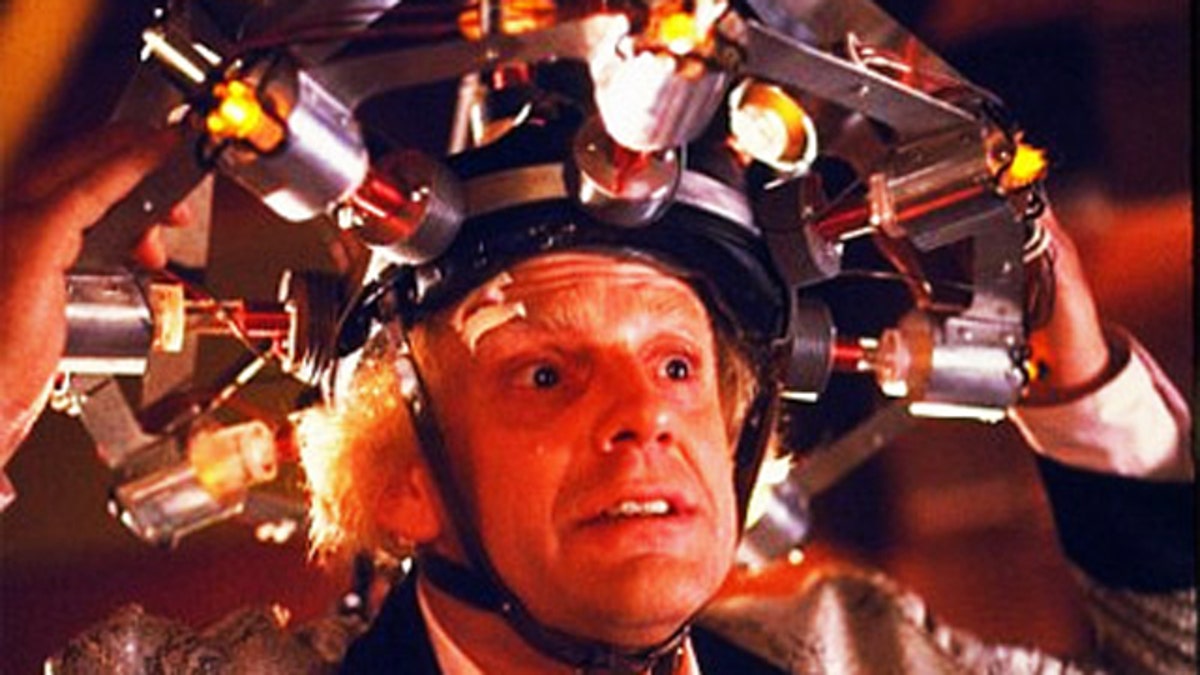
Doc Brown, the crazy inventor from Back to the Future, may not have perfected his mind-reading contraption, but real scientists are still trying. (Universal)
Would you consider swallowing a sponge on a string to help detect cancer in your stomach? Or propping open blood vessels in your brain -- with corn, so the prop can dissolve within two years? These cutting edge science ideas are real -- and may someday save your life.
1. Steer surgery with magnets
Doctors worry about heart murmurs, irregular heartbeats, and other anomalies that could signal heart arrhythmias, such as a slow pulse. Those conditions could be silent killers, leading to heart attacks or congestive failures. Dr. Kalyanam Shivkumar, director of the UCLA Cardiac Arrhythmia Center, has a new approach to treatment: magnets. The traditional method is to snake wire by hand up through the groin and apply a slight shock near the heart to "reset" the rhythms and get them back to normal. Using a machine developed by Stereotaxis that generates a magnetic field, surgeons can guide the wire more accurately without using their hands, aided by visualizations from mapping technology and X-rays.
2. Plant corn in the body
Stents are small metal devices used by surgeons to prop open passageways, such as blocked arteries -- some in the body, some in the brain. A new one, developed at Abbott Labs, is made from a corn-based polymer that dissolves naturally, starting after six months and vanishing fully after two years. The innovation eliminates a dangerous surgical procedure, since removal of the stent isn't necessary. Even though its name, the Bioresorbable Vascular Scaffold, sounds futuristic, it’s helping arteries in patients today regain the ability to flex, pulse, and respond just like an unblocked vessel.
3. Swallow a sponge, detect cancer
Scientists at the Medical Research Council in the UK have developed a sponge to detect cancer -- one that's attached to a string. First you swallow the sponge; it expands to about an inch in diameter, collecting cells for analysis. After about five minutes, doctors pull the sponge out using the string. In tests, the device, called a cytosponge, detected a type of cancer thought to develop in people with serious heartburn about 90% of the time.
4. Insert a light bulb, find a tumor
Serious tumors are often treated using chemotherapy, chemicals that kill tumors but affect the whole body. This can lead to hair loss, fatigue, and a weakened immune system, among the many side effects. A new technique, developed by Light Sciences Oncology, limits the effect of the drug -- through a tiny LED array (it's basically a light bulb) on a cord. The surgeon inserts it directly into the tumor using imagery from an ultrasound as a visual guide, then injects a drug into the body. The LED activates the drug only at the tumor, delivering targeted chemotherapy and reducing side effects on the rest of the body.
5. Burn out asthma
A new technique for dealing with asthma uses thermal energy to reduce the number of attacks. A tube is inserted into the patient's throat or mouth until it reaches the area where an asthma attack typically occurs. When there, a wire expands in the airway and uses radio frequency energy to heat the lung muscles there. This limits how much the muscles expand, lessening their ability to block breathing during an attack. Developed by Asthmatx, the Alair system makes trips to the emergency room less likely, and alleviates other complications with breathing and the respiratory system.
6. Find that lost surgical sponge
One of the most common mistakes a surgeon can make is forgetting to remove a surgical sponge. The new ClearCount SmartSponge system solves that problem by attaching a dime-sized RFID tag to each sponge. During a procedure, surgeons remove sponges and drop them into a bucket that automatically reconciles the sponges used. When the surgery is complete, the bucket will emit a green light to indicate that all sponges are accounted for. Staff can also use a SmartWand to scan a patient and see if any sponges were left behind. The patient can even receive a printed report about being sponge-free.
7. Pump you up -- literally
A new back-surgery procedure actually inflates degenerated disks in the back. The process, called fibrin sealant injections, is being tested at the Texas Spine and Joint Hospital to alleviate the constant pain of torn spinal disks, pain which can lead to hernias. Back surgeons inject the chemical fibrin directly into the disks to cause natural inflation and healing, ultimately restoring tissues in the back.
FoxNews.com's SciTech section is on Twitter! Follow us @fxnscitech.
